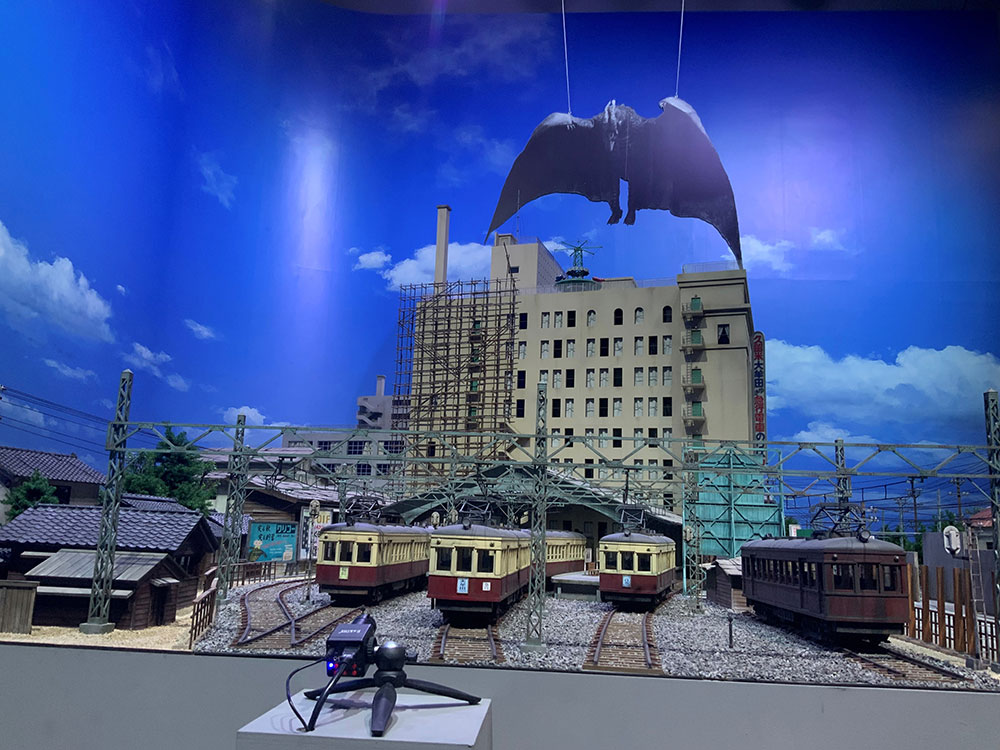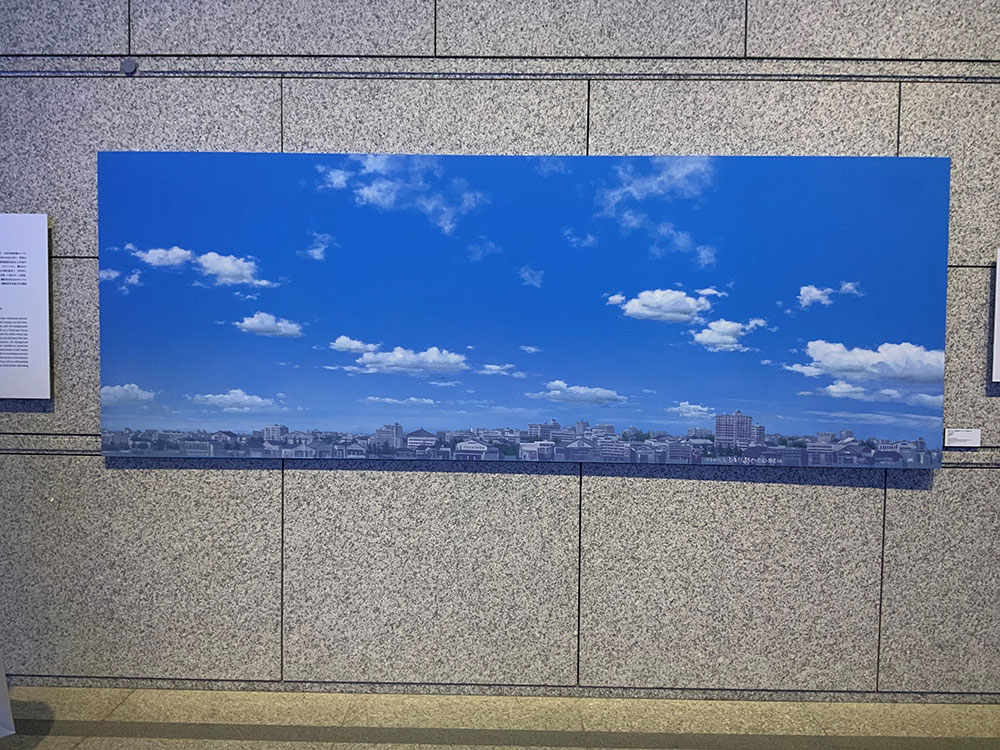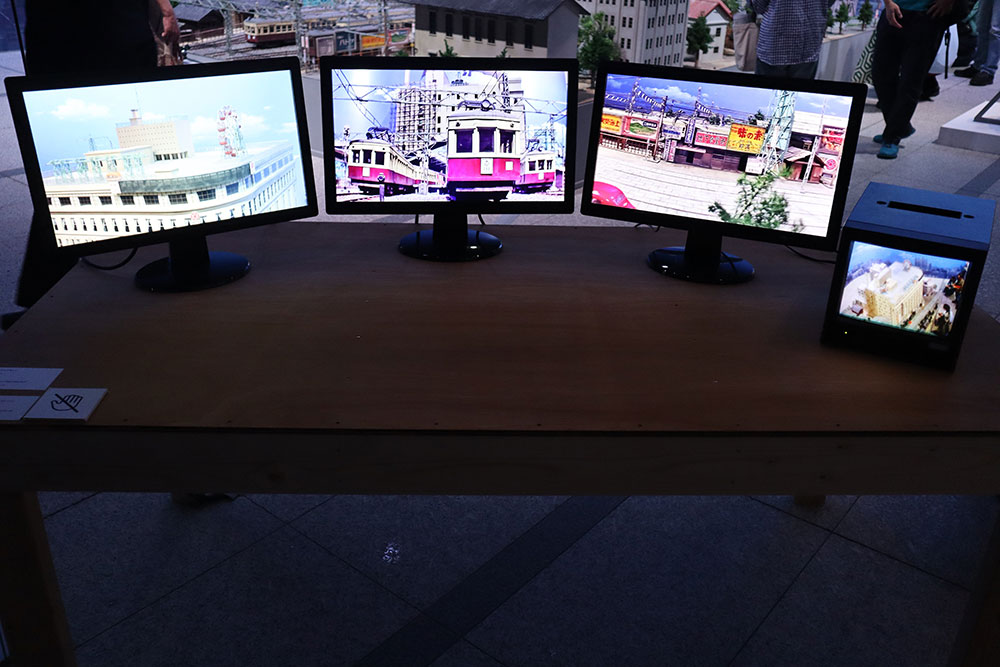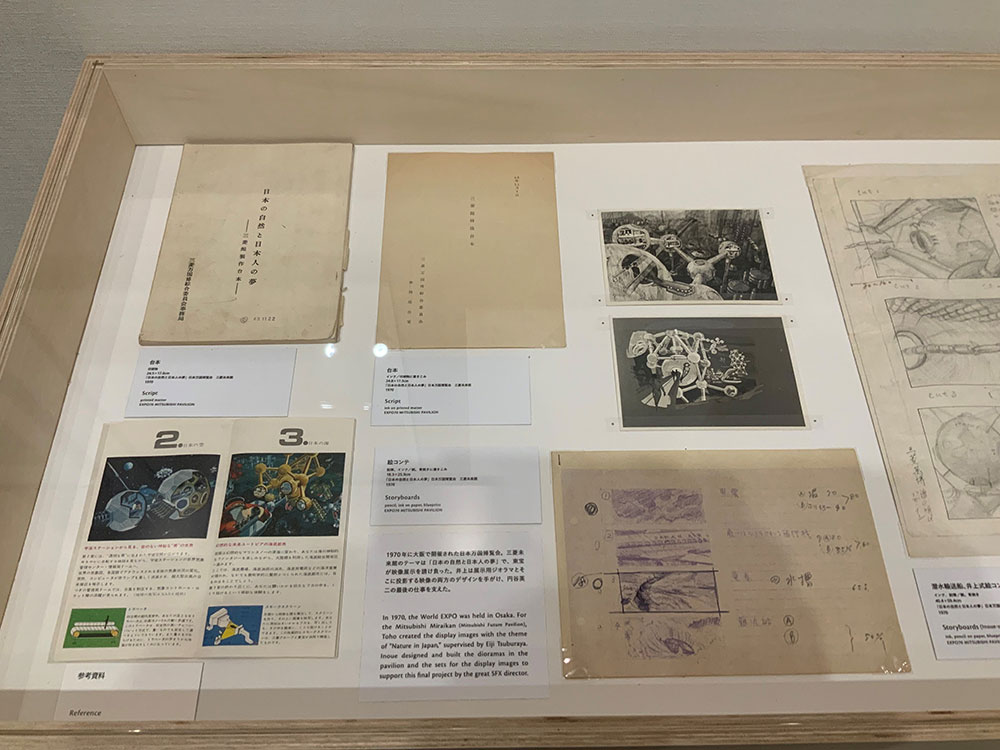SAKAGUCHI Masashi
This two-part interview was made with MIIKE Toshio, an active tokusatsu (special effects) art director, on the occasion of “The art of Special Effects Production Designer Yasuyuki ‘TAIKO’ Inoue” exhibition (hereinafter “Yasuyuki Inoue Exhibition”) held at the Museum of Contemporary Art Tokyo from March to June 2022. MIIKE talked about the work and legacies of tokusatsu art directors and INOUE Yasuyuki himself. In addition to INOUE’s work style, its uniqueness, and his relationship with NARITA Tohl that MIIKE talked about in the first part of the interview, this second part focuses on miniature sets, which are the centerpiece of the exhibition, and also INOUE’s work that went beyond special effects.

—Please talk about the reproduced Iwataya miniature set, which is the highlight of the “Yasuyuki Inoue Exhibition.” A miniature Iwataya itself was exhibited at a recent Inoue exhibition in Sasebo.1 This time, the set has been further developed into a townscape.
MIIKE Thank you. It was a long-standing matter requested by INOUE’s niece, TOGO Toyomi. As the miniature Iwataya exists, it facilitated to prepare for the Inoue exhibition in Tokyo. It ensures at least the Iwataya miniature itself can be exhibited, no matter what happens. Actually, I was worried whether we can afford planned facilities and equipment on a budget, such as a background picture and lighting. We made the background picture to be seven meters high, but at first some people said five meters would be sufficient.
—To make the background picture, you digitally enlarged a painting by the background picture artist SHIMAKURA Fuchimu.
MIIKE The ideal way to reproduce a shooting studio was to have SHIMAKURA paint with a spray gun. Unfortunately, spraying paint with a spray gun in the museum would require extensive masking. In addition, it was hard for SHIMAKURA to work from a vehicle for work at height, considering his age, so we decided to print it out. It was difficult to completely avoid reflection even on non-reflective print sheets. I was disappointed when seeing reflections of light on curved surfaces. However, the technique of joining print sheets together was excellent. The background picture was made by pasting the edges of sheets of roll paper about one meter wide together vertically. Each overlap between sheets is only about one centimeter and has no misalignment at all.

—Its surface looked so smooth and natural. Do you usually use digitally output background pictures in actual shooting?
MIIKE For a long time, we have been using enlarged photographs pasted on a flat surface. An example is a set of one office floor having a distant view of buildings through a window. Shooting just one flat surface outside the window by the camera from its front will not cause reflection very much.
—One of the new things in this exhibition is a Rodan board. I think it increased the appeal of the tokusatsu set.
MIIKE Hanging the Rodan board was suggested by ISHIZU Naoto of Neutral Corporation Ltd. He was also much involved in the “Director, Hideaki Anno’s ‘TOKUSATSU’ Special Effects Museum-Craftsmanship of Showa & Heisei eras seen through miniatures”2 and the “HIDEAKI ANNO EXHIBITION”.3 He plays the role of the art director for exhibitions.
—The method of using flat surfaces reminds me of cutout human figures4 used in the Giant God Warrior Appears in Tokyo (2012) and the “Kumamoto Castle x Tokusatsu Special Effects Art: Castle Revival Project” exhibition.5
MIIKE It may be interpreted that way, but since “Special Effects Museum,” we have displayed panels of enlarged monochrome photos of a flying Mechagodzilla and the super weapon Markalite Cannon (Marker-light FAHP) featured in The Mysterians (1957), for example. For the current exhibition, we prepared the Rodan panel for exhibiting a photo board work, rather than as a cutout photo for demonstrating a method of shooting.
—I see. I feel the Iwataya set in the current exhibition is further interesting as it can be interpreted in various ways like that. Also, there are several cameras installed in the set.
MIIKE Due to the restrictions on the exhibit, the visitors are not allowed to take photos other than from around the stage. In a set built for actual shooting, the staff with cameras aggressively enter the set. At this exhibition, cameras are installed with the set as a demonstration.
—Another camera is also installed directly above the set.
MIIKE We wanted to have the visitors feel the space like in a plan view between the floor and the sky relative to the main position. The resolution is so low that the images look like from a surveillance camera (laughs).
—In addition to the cameras shooting the set in real time, a video shot in advance was also playing on a monitor. It looked so realistic that it could easily been mistaken for showing a real city. It was interesting to find out how the same set can look so different depending on the type of shooting equipment and the shooting method.

—The “Yasuyuki Inoue Exhibition” includes not only materials related to works of the so-called “tokusatsu” genre, but also materials related to images from expositions. INOUE also worked on genres other than the “tokusatsu” genre, such as miniature objects for exhibiting at the Tobu World Square.
MIIKE Talents and knacks for special effects art are often required when making objects to be exhibited at museums, especially diorama-related works. In particular, working on dioramas that are constantly moved by mechanical systems is a challenging opportunity to demonstrate such talents. Weathering (giving touches of aging) and illumination of exhibits are also sometimes done by specialists from the film industry.
Sculptures used in film shooting only need to last for the duration of the shooting. But regarding exhibits, moving objects need to keep moving and exhibits outdoor need to last as long as possible without breaking or fading in color. They need to have expertise in durability, which is different from the expertise required for film. By doing such work, I believe he learned and accumulated new techniques, which contributed to improving his work in the film field.
—It is interesting specialists can leverage their techniques in such an interacting manner. It is not well-known that people doing tokusatsu work also produce such sculptures, I suppose.
MIIKE You are right. Actually, when the film industry started to decline, the Toho Tokubi6 (an organization in charge of tokusatsu art) was able to make use of its special skills in the exhibition field. In this respect, it was an excellent department in the Toho Studios that can earn money. Unfortunately, as a result, skilled staff members were headhunted by a famous theme park.
—A book by NAGANUMA Takashi,7 who worked for the Toho Tokubi for many years, features an example of applying, to dioramas, a tokusatsu technique for giving perspective to miniature sets. NARITA, in his book,8 also explains window display he did.
MIIKE There are many other jobs that require people having special effects art talents, such as advertisements and making sculptures for events. In many of such projects, however, those people are not allowed to have them known as creators in such projects due to contractual restrictions, so there are almost no documents and records left about their involvement. You may not be able to know unless COMMERCIAL PHOTO and other magazines publish their production processes along with the names of specialists or companies as their creators. Actually, there are many creations done by tokusatsu art specialists and the fact is unknown.

—In that sense, even people who are not aware of the tokusatsu genre may experience tokusatsu art without knowing.
MIIKE That’s right. There are also “unknown” tokusatsu effects in videos. As skillfully made tokusatsu effects are not noticed by the audience as tokusatsu, their contribution is not easily recognized. Even if they do notice, they often criticize tokusatsu effects, for example, as “looking cheap” or “merely a miniature” (laughs). If they are good, no one notices that they are tokusatsu. Tokusatsu that go unnoticed indicate that the specialists involved did a good job. But because they are unnoticed, they are not recognized as work, and it is difficult to get recognition within the film industry. It was not a problem when studios had power. Skilled specialists were automatically assigned to what they are good at doing. But now, independent specialists, in particular, cannot get a job to use their specialist skills as much as they want.
—Most people may not pay much attention to how videos are created with “tokusatsu” if they are not informed of tokusatsu’s involvement. They tend to simply think, “This looks realistic in the film, so it must be a real thing actually shot by the camera.”
MIIKE In addition, promotional advertisements tend to emphasize the production policy to “be as real as possible,” by saying: “We are shooting at a full-scale set by spending huge cost,” or “We are shooting on location in a real tough condition.” So using tokusatsu tends to be hidden even if the finished work is successful.
—In the 1990s and 2000s, the use of state-of-the-art computer graphics in films was much stressed in their advertisements, resulting in putting tokusatsu in the shade. Tokusatsu is in a dilemma. When they are good, they will remain unknown. As a result, only “tokusatsu” as a genre tends to be highly evaluated.
MIIKE The same is true for art effects for the honpen part, which does not use tokusatsu in shooting. For example, when you make an elaborate store set used in a drama, people seeing the drama tend to think that the actual store was used for shooting. Actually, rooms to be used in important scenes are usually sets. Also, to apply lighting from above to capture desired images, there is no ceiling made. Walls are made removable to contain the camera. But the audience do not notice these things. Although many excellent sets have been made for films for many years, contribution by the art staff has not been talked about very much.
—In that sense, it is a dilemma that their involvement is unnoticed and therefore it can contribute to the work. It is not limited to tokusatsu.
MIIKE Right. The lack of public recognition of the role played by the art staff and the need to improve their status in the film industry are often discussed by the Association of Production Designers in Japan.
—To change the situation, I feel it is necessary to show making-ofs of tokusatsu to the public. In the tokusatsu genre, making-ofs themselves are treated as a content, such as their techniques featured in magazines in the past and bonus tokusatsu making-of videos included in video software.
MIIKE Giant God Warrior Appears in Tokyo was designed to make its making-of interesting. In contrast, some companies and producers will not show making-ofs of some films as they think presenting their behind-the-scenes can disillusion the audience.
—It is said that director TSUBURAYA Eiji was reluctant to show behind-the-scenes. Considering these genre-specific dilemmas, I think this exhibition is very significant in that it focuses on INOUE Yasuyuki, a specialist who played a major role behind the scenes.
MIIKE Thank you. There are many specialists other than INOUE who are not well known despite having great skills. I will continue making efforts to make these people known little by little.
—I am looking forward to seeing the development in the future. Thank you very much for your time.
notes
information
The art of Special Effects Production Designer Yasuyuki “TAIKO” Inoue
Dates: March 19 (Sat.)–June 19 (Sun.), 2022
Closed: Mondays (open on March 21), March 22
Venue: Museum of Contemporary Art Tokyo, B2F
Admission: 1,700 yen for adults; 1,200 yen for college/university/vocational school students and people at the age of 65 and older; 600 yen for junior high and high school students; free for elementary school students and younger
https://www.mot-art-museum.jp/en/exhibitions/yasuyuki-inoue/
*URL links were confirmed on June 2, 2022.